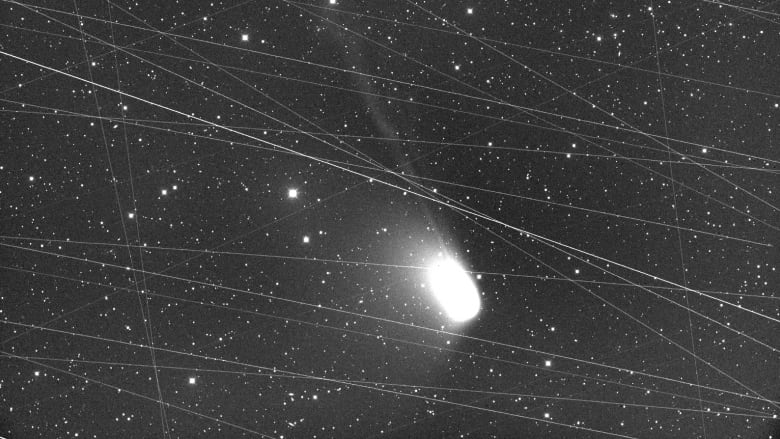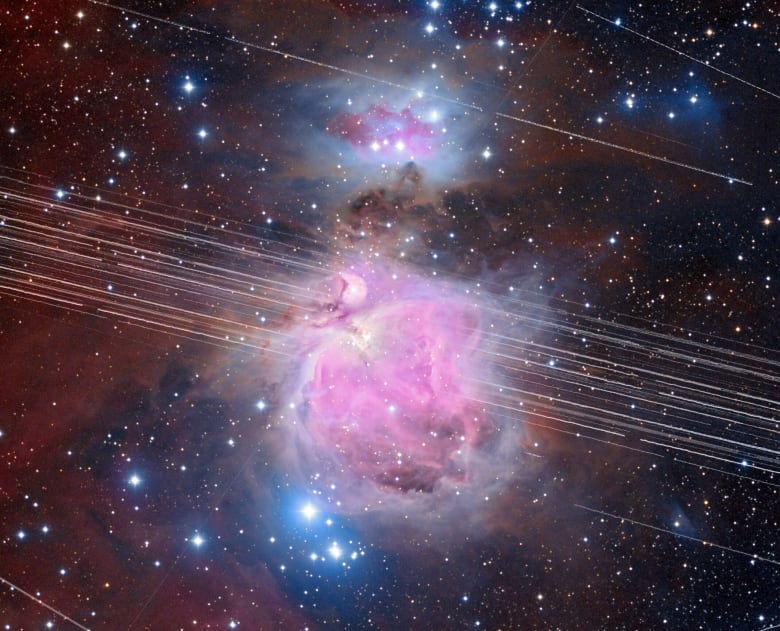Starlink satellites create light pollution and disrupt radio frequencies. And it's getting worse
Thousands of satellites in low-Earth orbit are still lighting up the sky, frustrating astronomers

Look up at the night skyfrom a city where most people live and you'll see just a smattering of stars. Perhaps even an airplane or two.
But drive further out, past the glare of lights from houses, cars, office buildings and street lamps, and the stars reveal themselves in a way that few have truly seen.
Now, it seems the night sky is under attack not only from below, but from above, thanks to the rapid proliferation of satellites, mainly megaconstellations, which can contain hundreds or thousands of satellites. And leading the charge is SpaceX.
The company launched its first batch of 60 Starlink satellites in 2019. Soon, they were showing up in data from professional astronomical institutions.
Knowing that SpaceX was proposing thousands more, the International Astronomical Union created the Centre for the Protection of the Dark and Quiet Sky from Satellite Constellation Interference.
SpaceX immediately agreed to work with the astronomical community. But despitereassurances from SpaceX COO Gwynne Shotwell in 2020 that they "are going to get it done" and fix the problem, it's still an ongoing issue threatening astronomical research.
The problem for astronomers is two-fold: passing Starlink satellites create long lines through images taken withoptical telescopesand create "noise" for radio telescopes, which rely on specific radio frequencies.

"I want to be very clear that satellite infrastructure is incredibly important, and we all recognize that. So that's not the argument," said Aaron Boley, an associate professor and Canada research chair in planetary astronomy at the University of British Columbia.
"The argument is, ultimately, how much infrastructure in orbit do we need? How much can we put up there safely?" he said. "How much can we put up there without having very long-term impacts on the environment?"
'Wild West'
One mightsay that since space is vast, we shouldn't be so concerned. But the fact is,there are specific orbits where satellites need to be, and it's getting crowded.
There'safear that it's getting so crowded that it could produce the Kessler effect, where one satellite is destroyed, which in turn destroys another and another (just think of the movie Gravity). And that would most certainly affect us here on Earth, givenour reliance on satellites for weather information, GPS andmore.
Starlinks have a lifespan of just five years,so when they've reached their end of life, they fall back down to Earth,burning up in our atmosphere, leaving behindmetals, and it's unclear what those long-term effects will be.
We've had satellites ever since Sputnik 1 launched in 1957. But today, the numbers are mind-boggling.
In 1958, eight satellites were launched. By 1967,that number rose to 159. After that,roughly 40 to 150 satellites were launched annually. Fast forward to 2023, and more than 2,600 satellites were launched.
Of all the satellites now in orbit, SpaceX owns more than half. And they plan to have a megaconstellation of roughly 42,000 satellites.
Meredith Rawls, a research scientist in the University of Washington's department of astronomy, explains what it's like trying to do research with so many satellites crossing the sky.
"[It's like]trying to look through like a dirty windshield to do your science, and there's just all this stuff everywhere," she said.
"I think that we're just on an unsustainable path right now.... International co-ordination is not a priority on anyone's radar right now, and it's more like a kind of a Wild West-based race situation," Rawls said.
SpaceX did not immediately respond to a CBCrequest for comment.
Little progress
To be fair, the company has worked with the International Astronomical Union to try to mitigate the effects on astronomical research, but so far, it doesn't seem like any real progress has been made.
SpaceX tried a different coatingon its satellites early on in order to reduce optical brightness and even a type of shield. Neither truly worked.

This summer, there was some promising news for radio astronomers.
On Aug. 9, SpaceX announced new techniques they developed along with the National Science Foundation and the National Radio Astronomy Observatory that would help radio astronomers by steering the radio emission beams away from radio telescopes.
The good news didn't last very long. That same day, a new paper published in the journalAstronomy & Astrophysicsfound Starlink satellites are unintentionally leaking electromagnetic radiation in low frequencies.
"Even without the direct transmission, these satellites produce electromagnetic radiation in radio wavelengths just from their electronics. And it's actually quite radio loud, and so the telescopes are able to pick it up pretty easily," Boley said.
From seeing red to seeing blue
There's another new problem: While initially Starlink satellites appeared red, their new V2 satellitesappearblue.
"This is a consequence, we think, of the coating that's been put on the new Starlink satellites, and overall it is to help reduce their visibility, which is a good thing," Boley said.
However, these satellites are bigger. What would have been a reduction for the earlier satellitesis now scattering more blue light, making them appear somewhat brighter.
WATCH | Why are Starlinks appearing blue?
To most people, the night sky is likely not a priority when it comes to pollution, be it in the form of light or radio waves. But it has played an important role not only in terms of applicable scientific research, butin ourevolution: the night sky influencedthe earliest humans, helpingproduce scientific curiosity about theworld around usand providing inspiration in art, culture and almost every aspect of our development.
But now, the Milky Way ishidden from more than one-third of humanity, and from more than 80 per cent of North Americans.
The question is, if SpaceX is trying to work with the astronomical community and making little progress, what are other players going to do? SpaceX isn't the only onelaunching these constellations China plans to launch 40,000 of its own, and there are other companies, such asOneWeb, that propose hundreds.
What happens to astronomy and our night sky if satellite operatorsdon't even want to try to fix the problemof light and radio pollution?
"I feel a little pessimistic in that it's billion-dollar industry versusscience," saidVictoria Kaspi, an astrophysicist at McGill University in Montreal who works with the Canadian Hydrogen Intensity Mapping Experiment (CHIME) radio telescope in British Columbia.
"To me, it feels like, really, the only way to manage this would be through public opinion, if there was a groundswell of appreciation for this light pollution."












_(720p).jpg)


 OFFICIAL HD MUSIC VIDEO.jpg)
.jpg)



























































































